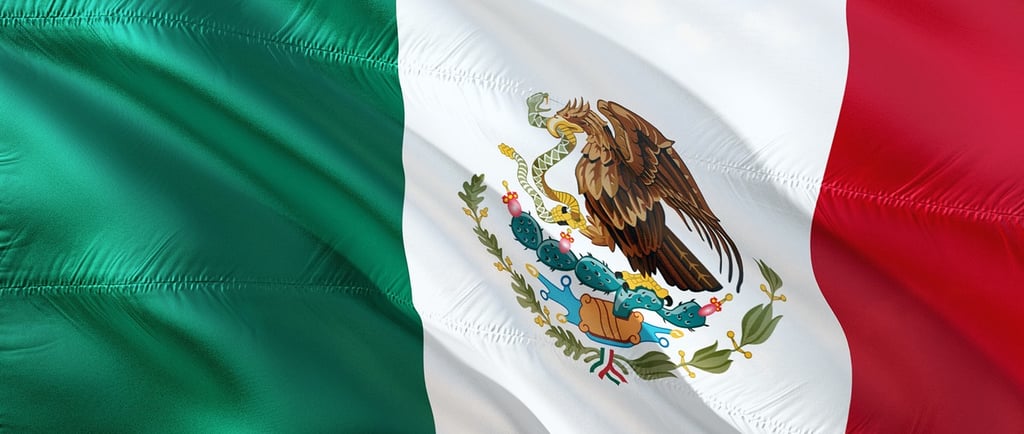🇲🇽 The Flag of Mexico - Eagle of the Aztecs 🦅
A flag story invites children into the fascinating world of symbols, colors, and shapes that represent countries around the globe. 🌍🇦🇺🇫🇷 In "Flags of the World," each flag reveals a story—of ancient legends, natural landscapes, and the hopes and dreams of a nation’s people. 🌞🏔️ This exploration encourages children to see flags not only as symbols but as connections to the world’s shared heritage, inspiring questions like, “Why these colors?” and “What does this symbol mean?”
GEOGRAPHY STORIES
11/8/20243 min read


Remember the other day we talked about colors. How people started making different pigments from grinding rocks and mummies , crushing snails and bugs and even soaking up leaves. As you know each country has a flag, today I want to share one of the many flag stories with you.
Mexico’s flag is full of color and a special symbol that tells an ancient story. But do you know what makes this flag so meaningful?
🟥🟩 Mexico’s flag has three bold colors: green, white, and red. Each one has a special meaning:Green stands for hope and the fertile land of Mexico.White represents peace and unity among the people.Red symbolizes the courage and sacrifices made by Mexico’s heroes in their fight for freedom.But there’s more to the flag than colors! Right in the center of the white stripe, there’s an interesting symbol with a golden eagle 🦅 perched on a cactus eating a snake. 🌵.
🦅🌵 The Eagle on the Cactus symbol comes from an ancient Aztec legend. Long ago, the Aztec people were looking for a sign from their gods to show them where to build their new city. They were told from the wise man to look for an eagle sitting on a cactus, eating a snake 🐍. After a long journey, they finally saw this sight on an island in the middle of a lake! They built their city, Tenochtitlán, in that very spot, which later became Mexico City. This symbol is a reminder of the Aztec roots and rich history of Mexico.
📅 Over the years, Mexico’s flag has changed designs a few times, but the eagle on the cactus has always remained at its heart. The current design of the flag was officially adopted in 1968 and is now celebrated every year on February 24th as Día de la Bandera or Flag Day! On this special day, Mexicans honor their flag, reflecting on the stories,legends, colors, and symbols that bring the nation together.
Whenever you see Mexico’s flag 🇲🇽, remember the legend of the eagle , the bravery of the people that helped them unite! And there are other flag stories which you can find in the Geography shelf.
Follow-Up Projects 🌍🏳️🌈
🎶 National Anthem: Mexico’s national anthem, “Himno Nacional Mexicano,” is an exciting and powerful song! Listen to the anthem’s bold rhythm, which inspires pride and unity. How does it sound compared to other anthems you know? Discover the traditional instruments that bring Mexico’s music to life and the meaning behind the anthem’s words, which honor Mexico’s strength, freedom, and beauty.
🥘🌵🦅 National Symbols: Mexico is filled with colorful symbols of its heritage! Discover the story of the eagle and cactus on the flag, inspired by an ancient Aztec legend that guided them to their homeland. Learn about Mexico’s national flower, the dahlia, and the xoloitzcuintli (or "Xolo"), a unique Mexican dog breed that’s been a loyal companion for thousands of years. And of course, don’t forget tacos and chiles—foods that represent Mexico’s lively culture and delicious cuisine! What do these symbols tell us about Mexico’s history, nature, and traditions?
✍️ Write Flag Stories: Imagine creating your own story about a country’s flag! Choose any flag that fascinates you and think about its colors and symbols. What do they mean to you?
🗺️ Note for Flag Presentations:
I will present one story for a flag, while the rest of the flag stories will be printed as materials for the Geography shelf. When sharing a flag story, I’ll use a map to show where the country is located, helping children connect the flag with the country's geography and understand its place in the world. This approach not only gives context to to the story but also encourages children to explore maps, learn about continents and countries, and discover how geography shapes culture.
With Montessori joy,
Vanina 😊

